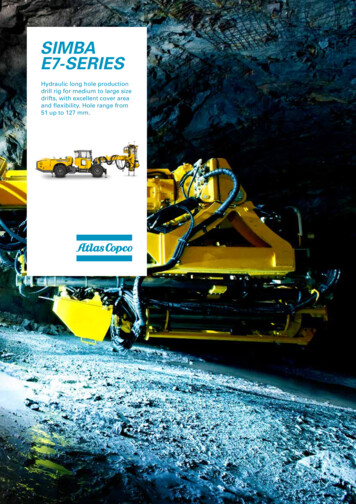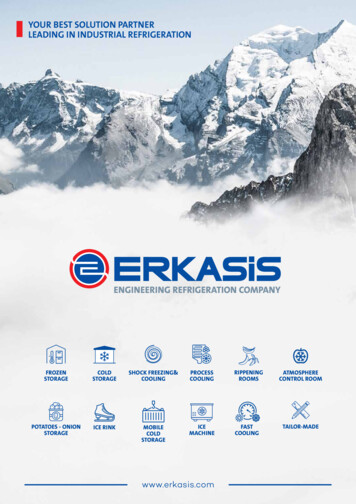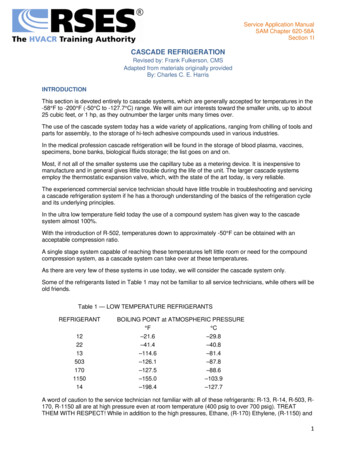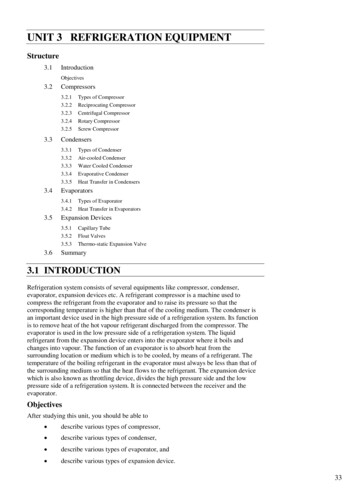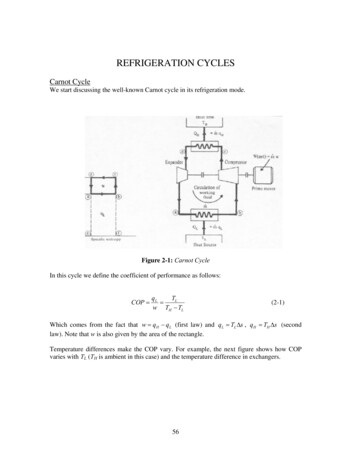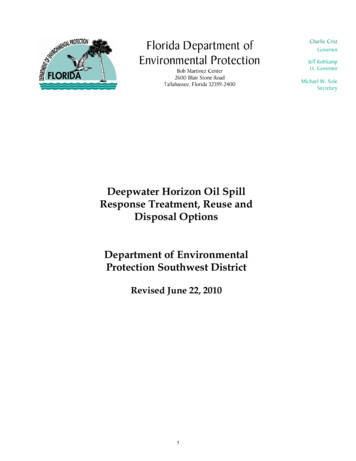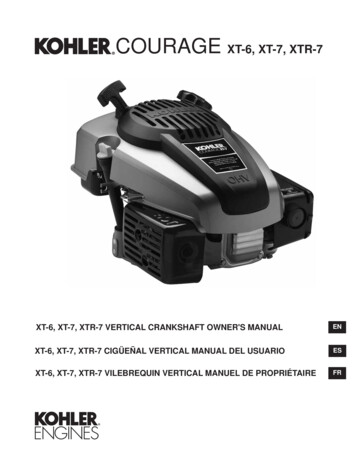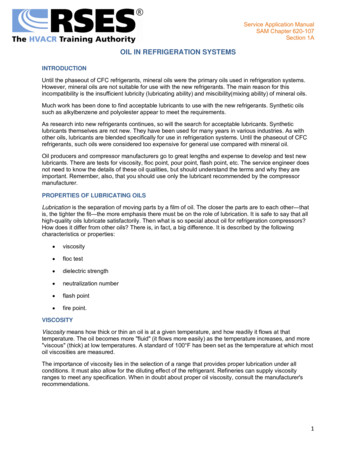
Transcription
Service Application ManualSAM Chapter 620-107Section 1AOIL IN REFRIGERATION SYSTEMSINTRODUCTIONUntil the phaseout of CFC refrigerants, mineral oils were the primary oils used in refrigeration systems.However, mineral oils are not suitable for use with the new refrigerants. The main reason for thisincompatibility is the insufficient lubricity (lubricating ability) and miscibility(mixing ability) of mineral oils.Much work has been done to find acceptable lubricants to use with the new refrigerants. Synthetic oilssuch as alkylbenzene and polyolester appear to meet the requirements.As research into new refrigerants continues, so will the search for acceptable lubricants. Syntheticlubricants themselves are not new. They have been used for many years in various industries. As withother oils, lubricants are blended specifically for use in refrigeration systems. Until the phaseout of CFCrefrigerants, such oils were considered too expensive for general use compared with mineral oil.Oil producers and compressor manufacturers go to great lengths and expense to develop and test newlubricants. There are tests for viscosity, floc point, pour point, flash point, etc. The service engineer doesnot need to know the details of these oil qualities, but should understand the terms and why they areimportant. Remember, also, that you should use only the lubricant recommended by the compressormanufacturer.PROPERTIES OF LUBRICATING OILSLubrication is the separation of moving parts by a film of oil. The closer the parts are to each other—thatis, the tighter the fit—the more emphasis there must be on the role of lubrication. It is safe to say that allhigh-quality oils lubricate satisfactorily. Then what is so special about oil for refrigeration compressors?How does it differ from other oils? There is, in fact, a big difference. It is described by the followingcharacteristics or properties: viscosity floc test dielectric strength neutralization number flash point fire point.VISCOSITYViscosity means how thick or thin an oil is at a given temperature, and how readily it flows at thattemperature. The oil becomes more "fluid" (it flows more easily) as the temperature increases, and more"viscous" (thick) at low temperatures. A standard of 100 F has been set as the temperature at which mostoil viscosities are measured.The importance of viscosity lies in the selection of a range that provides proper lubrication under allconditions. It must also allow for the diluting effect of the refrigerant. Refineries can supply viscosityranges to meet any specification. When in doubt about proper oil viscosity, consult the manufacturer'srecommendations.1
Service Application ManualSAM Chapter 620-107Section 1AOIL IN REFRIGERATION SYSTEMSFLOC TESTAll mineral oils contain paraffin wax, some more than others. Even those that are called "wax-free"contain very small amounts of wax. The floc test determines the measurable temperature at which waxseparates from an oil. The small amounts of wax in "wax-free" oils will settle out in a mass(flocculate)onlywhen oil/refrigerant mixtures are at very low temperatures.In general, the solubility of a material (its ability to be dissolved in a solvent) decreases as thetemperature of the solvent decreases. In the same way, as the temperature of an oil/refrigerant mixture islowered, the solubility of the paraffin wax decreases. If there is more wax present in an oil/refrigerantmixture than can remain in solution at a given temperature, precipitation will take place.DIELECTRIC STRENGTHDielectric strength is a measure of the resistance of an oil to an electric current. It is expressed inthousands of volts (kilovolts, or kV) of electricity required to jump a gap of 0.1 in. between two polesimmersed in the oil. Recommended dielectric strength is a minimum of 25 kV.NEUTRALIZATION NUMBERNeutrality is a difficult thing to visualize. Chemically, it is something that is neither alkaline nor acidic. Theconcept of neutrality may take on more meaning if you think of it in terms of drinking water. Householdammonia is alkaline, and vinegar is acidic. By contrast, ordinary drinking water is neutral. Nearly alllubricating oils contain materials of varied and uncertain chemical composition, which react with alkali.These substances are known as organic acids. They should not be confused with corrosive mineralacids,which are never found in properly refined oils. Mineral acids, if present, are detected by theneutralization number test. A low neutralization number indicates the absence of corrosive mineral acids.FLASH POINT AND FIRE POINTIf you heat an oil in an open container and pass a small gas flame over the surface of the oil, at somepoint there will be a flash of fire on the surface as the oil vapor burns. The temperature at which thisoccurs is called the flash point. If you heat the oil further, it will reach a point at which it can be ignited andwill continue to burn. This temperature is called the fire point.SOLUBILITYOil in a refrigeration system must do more than simply meet the normal requirements of lubrication. Itmust be able to mix with the refrigerant and travel through the system. Therefore, you must consider thesolubility relationships between refrigerants and oils. Refrigerants fall into three groups: Those that mix in all proportions with oil in the range of temperature operation. These include R12, R-113, ethane, propane, isobutane, and the other hydrocarbons. Those that separate into two phases in the operating range, depending on temperature, pressure,and type base stock (chemical category) of the oil. These include R-21, R-22, R-114, and R-115. Those that are insoluble in oil in the operating temperature range. These include R-13, R-14,ammonia, and carbon dioxide.Of the refrigerants listed in the last two groups, only ammonia and carbon dioxide are lighter than oil.They float on top when the oil/refrigerant mixture separates into two phases.2
Service Application ManualSAM Chapter 620-107Section 1AOIL IN REFRIGERATION SYSTEMSOf the refrigerants that undergo phase separation during operation, only R-13 and R-22 have causedproblems. These problems can be avoided through proper design. Several important factors help to keepoil from accumulating in the evaporator, which causes "oil logging." The factors include the following: proper evaporator design proper capacity balance with the compressor correct refrigerant line sizing avoidance of improper traps installation of properly designed traps.High-side oil separators may help in some installations, especially low-temperature ones. Suchseparators are not 100% efficient, but they can keep the compressor from passing excessive amounts ofoil to the evaporator.R-13 OIL PROBLEMSPour point difficulties are encountered with R-13 when capillary tubes and expansion valves are used asflow control devices. (The pour point of an oil is the temperature at which it ceases to flow, because ofhigh viscosity.)Field reports on R-13 indicate that there is less trouble with expansion valves. A lowviscosity oil (80 to 90 Saybolt Seconds Universal, or SSU) with a very low pour point may be the solution.R-13 is used as a replacement for ethane, often found in the low stage of low-temperature cascadesystems.R-22 OIL PROBLEMSR-22 is more widely used than R-13. An oil in which R-22 is readily soluble has been the object ofintensive research by manufacturers of condensing units. Solubility varies somewhat with the type basestock of the oil used. In low-temperature operations, many problems are caused by the oil being held upin the evaporator. The first indication in many cases has been the extensive damage to compressorscaused by inadequate lubrication. The inadequate lubrication, in turn, is caused by insufficient oil return.WHY DO PROBLEMS EXIST?Oil is used in refrigeration systems to lubricate compressor bearings and other moving parts. Theproperties of the oil selected must be suitable for this purpose. In an automotive engine, motor oil stays inthe crankcase where it belongs. If refrigerant oil did the same thing—that is, if it remained in thecompressor crankcase—it would eliminate many oil-related problems in refrigeration systems.3
Service Application ManualSAM Chapter 620-107Section 1AOIL IN REFRIGERATION SYSTEMSFIGURE 1. LOSS OF CAPACITY WHEN OIL IS PRESENT IN R-12However, in a refrigeration system, oil is carried through the compressor by the refrigerant. It circulateswith the refrigerant throughout the system. A small amount of oil in circulation is not harmful. In fact, itmay be of some benefit in lubricating valves, etc. Large amounts of oil, however, create problems.Consider the following four areas of concern.First, oil circulating with the refrigerant is not in the compressor crankcase where it should be. This can bea major problem. A shortage of oil may develop in the crankcase. As a result, bearings and other partsmay not be properly lubricated. Adding more oil after start-up to compensate is not a solution, becausethe amount of oil circulating with the refrigerant is not consistent throughout the system. Excess oil mayaccumulate in the evaporator and then return to the compressor in a slug. This could overfill thecrankcase and possibly damage the compressor.Second, excessive amounts of oil in an evaporator decrease the capacity of a system. Figure 1 shows thetypical result in an R-12 system. Heat transfer through the coil wall decreases. The coil area is less if partof the space is occupied by oil. Both of these factors produce a larger temperature difference (TD)between load and evaporating refrigerant. Increased TD in the evaporator indicates a decrease incapacity. Capacity is further reduced to the extent that the vapor pressure of a refrigerant/oil solution isless than that of a refrigerant alone. If suction pressure controls the compressor, it stops running at ahigher temperature when vapor pressure is reduced. If evaporating temperature controls the compressor,then it runs longer to maintain a given temperature when vapor pressure is reduced.Third, oil in the refrigerant may cause restrictions in expansion valves or capillaries, and thus reducerefrigerant flow. Improvements in oil quality have greatly reduced this problem, but restrictions may stilloccur in unusual circumstances.Finally, circulating oil may break down at hot spots in the system and cause varnishing and valve sticking.It may react with the refrigerant at high temperatures and form acids.AMOUNT OF OIL CIRCULATEDIn the field, it is hard to find out how much oil is circulating with the refrigerant. It helps to know thecomplete history of the equipment. On larger equipment, you can observe the oil level in the crankcase.However, if oil has been added, the crankcase level may not indicate the correct oil charge.A loss of capacity might indicate excess oil in the evaporator. For example,a system operating with lowcapacity might return to normal after a brief shutdown, or after hot-gas defrosting. Oil in the evaporatormight be blown out when the coil is warmer than normal. If this occurs, the result is a gradual loss incapacity until the coil warms up again.OIL IN THE EVAPORATORMany oil-related problems are caused by oil collecting in the evaporator. You need to understand theproperties of refrigerant/oil mixtures in this part of the system.FACTORS AFFECTING OIL IN THE EVAPORATORWhen there is oil in the evaporator, three factors determine whether or not it stays there: the viscosity or fluidity of the oil the velocity of the refrigerant gas the geometry of the piping.4
Service Application ManualSAM Chapter 620-107Section 1AOIL IN REFRIGERATION SYSTEMSOil itself is quite fluid and has a relatively low viscosity at ordinary temperatures. At lowertemperatures, the oil becomes more viscous. It becomes more difficult to pour or flow. At very lowtemperatures, it becomes solid. Whether refrigerant vapor can push oil out of the evaporatordepends on how fluid or viscous the oil is. Remember that refrigerant itself has very low viscosity.Solutions of oil and refrigerant have a viscosity between that of the oil and that of the refrigerant.As more refrigerant dissolves in the oil, the solution becomes less viscous.CHANGING CONDITIONS IN THE EVAPORATORFigure 2 shows some changes that take place in an evaporator. The diagrams are intended to illustrateconditions, not quantitative changes. The beginning of the evaporator coil is filled with liquid refrigerant. Itcontains a small amount of oil. It moves along the evaporator and evaporates, leaving oil behind. Whenliquid refrigerant evaporates, the temperature rises. When the temperature goes up, some of therefrigerant dissolved in the oil is forced out.FIGURE 2. CHANGING CONDITIONS IN THE EVAPORATOR AND SUCTION LINEThe bottom diagram shows changes in viscosity at different points in the evaporator. At the inlet, theviscosity of a liquid refrigerant containing a small amount of oil is very low. When superheating begins,refrigerant evaporates from the oil. Viscosity begins to increase quite rapidly. At some point along the line,it reaches a maximum value. Then, viscosity slowly decreases as temperature rises. The location of thisarea of maximum viscosity is important. It is here that the velocity of refrigerant vapor must be able topush oil through the tube. It must push it to a place where higher temperatures make it more fluid.5
Service Application ManualSAM Chapter 620-107Section 1AOIL IN REFRIGERATION SYSTEMSMEASUREMENTS OF VISCOSITYThe viscosities of solutions of a naphthionic base oil and various refrigerants have been measured underconditions similar to those found in an evaporator. Figure 3 shows the results with R-12, R-22, and R-502.FIGURE 3. VISCOSITY CHANGES IN R-12, R-22, AND R-502The viscosity of mixtures containing a large amount of refrigerant is very low. When the refrigerant hasevaporated, the viscosity of the oil left behind rises rapidly. However, if the temperature continues toincrease after the refrigerant has escaped from the oil, the oil will become more "fluid" (its viscosity willdecrease). The curves in Figure 3 represent changes in viscosity when pressure remains constant. Suchwould be the case in the evaporator and suction line. Note that the point where viscosity is highest isnever the coldest location. There is always enough refrigerant dissolved in oil at lower temperatures toaffect viscosity. Also, viscosity is lower at higher pressures because more refrigerant is dissolved in theoil.The effect of R-22 and R-502 on the viscosity of oil solutions is about equal. Solutions with R-12 havelower viscosities.The curves in Figure 3 show quantitatively the viscosity changes represented in Figure 2. When liquidrefrigerant is present, viscosity stays low, even at low temperatures. As soon as temperature rises (whensuperheating begins), viscosity goes up rapidly. For example, when evaporation is at 40 F, the oilviscosity has increased greatly by the time the gas temperature reaches 35 F. The point of highestviscosity is at a gas temperature of about 10 F for both R-22 and R-502. This corresponds to asuperheat of 30 F.You might assume that oil is most difficult to move in the coldest part of the evaporator, but theseviscosity measurements show that this is not so. Refrigerant gas is more soluble in oil at lowtemperatures than at high temperatures at the same pressure—or, in other words, near saturationconditions. In many systems, the point of highest viscosity may be outside the evaporator. In this case, itwould help to raise the suction-line temperature quickly. If a liquid-vapor heat exchanger is used, locate itclose to the evaporator to keep superheat low.SOLUBILITY OF REFRIGERANTS IN OILThe viscosity of refrigerant/oil solutions relates to the solubility of the refrigerant in the oil. Relativesolubilities of R-12, R-22,and R-502 are shown in Figure 4. Data are for the same evaporating6
Service Application ManualSAM Chapter 620-107Section 1AOIL IN REFRIGERATION SYSTEMStemperature, but pressures are different. They correspond to the vapor pressure of the refrigerant at eachtemperature. Note that the solubility of R-22 is slightly higher than that of R-502 at 40 F. However, theirsolubilities are about the same when oil temperature rises. The solubility of R-12 in oil is far greater thanin other refrigerants at low temperatures, and still higher when the oil is warm. This difference in solubilityexplains the lower viscosity found in R-12/ oil solutions and the better oil return usually found in R-12systems.FIGURE 4. SOLUBILITY OF REFRIGERANTS IN OIL AT CONSTANT PRESSUREIt was noted earlier that some refrigerant/oil solutions separate into two liquid phases at lowtemperatures. Figure 5 shows examples of this for R-22 and R-502. Regarding oil return, the formation oftwo liquid phases is not important in a dry-type evaporator. The principal factor is the viscosity of the oil.And the viscosity of the oil, in turn, depends on the amount of refrigerant dissolved. With R-502, two liquidphases form at a far higher temperature than R-22. However, viscosities of their oil solutions are aboutthe same. At 40 F, the oil phase contains about 20% R-502, or about 27% R-22, as shown in Figure 4.7
Service Application ManualSAM Chapter 620-107Section 1AOIL IN REFRIGERATION SYSTEMSFIGURE 5. LIQUID PHASES OF R-22 AND R-502In each case, enough refrigerant is dissolved in the oil to cause low viscosity.In flooded evaporators, it is important whether or not two liquid phases form. If they do, the oil return mustbe handled differently than if the oil is completely miscible at low temperatures.REDUCING THE AMOUNT OF OIL CIRCULATEDAs noted earlier, the compressor may not be properly lubricated if too much oil circulates with therefrigerant. There may be a drop in capacity, as well as other problems. Knowledge of refrigerant/oilrelationships at higher temperatures will help you find methods of keeping oil in the crankcase where itbelongs.PREVENTING REFRIGERANT BUILDUP IN THE CRANKCASELubricating oil tends to dissolve appreciable amounts of refrigerants at temperatures found in thecompressor crankcase. But the amounts vary for different refrigerants. For example, assume that you arelooking at the differences in solubility of R-12, R-22, and R-502. At 85 F and 60 psig, a typical oildissolves about 35% of R-12, 11% of R-22, and 7.5% of R-502 by weight. When a cold compressor % byweight is started, pressure drops rapidly and the temperature of the oil rises. As a result, the solubility ofthe refrigerant is sharply decreased. There will be a rush of gas out of the oil over a very short period oftime. The drop in crankcase pressure causes oil foaming.When this occurs, an excessive amount of oil may be carried with the refrigerant through and beyond thecompressor. There is a good way to prevent refrigerant buildup in the crankcase—just be sure that the oiltemperature is kept above that of the liquid refrigerant elsewhere in the system.CRANKCASE HEATERSA small electric heater immersed in the crankcase oil is often used to maintain adequate oil temperatures.The amount of refrigerant dissolved in crankcase oil depends on the temperature of the oil and thetemperature of pure refrigerant elsewhere in the system. The temperature of liquid refrigerant determinesits vapor pressure. Figure 6 shows these relationships and gives some examples.8
Service Application ManualSAM Chapter 620-107Section 1AOIL IN REFRIGERATION SYSTEMSFIGURE 6. SOLUBILITY OF R-22 IN OILExample:For example, if liquid R-22 is at 70 F and the pressure in the crankcase is the same as the vaporpressure of the refrigerant, the oil will contain 10% R-22 when the temperature is 150 F. Under thesame conditions, the solubility of R-22 will be 20% when the oil temperature is 100 F. When liquidR-22 is 40 F with a vapor pressure of 68 psig, the solubility of the refrigerant will be 10% in oil at100 F.SOLUBILITY UNDER OPERATINGThe ideal situation would be to maintain the temperature of the oil, when a system is shut down, so thatthe concentration of refrigerant is no greater than it is when the system is operating. Table 1 givesexamples of oil/refrigerant relationships under operating conditions for R-12, R-22, and R-502. You cansee that, in general, the concentration of refrigerant in oil is quite low. For a given refrigerant, the solubilitydecreases as the oil temperature increases. Solubility also is less at lower evaporating temperatures forthe same oil temperature. Ideally, as noted above, it would be desirable to keep the refrigerantconcentration in oil at these low levels while the system is idle.Table 1. Solubility Of Refrigerants In Oil Under Operating Conditions, % By WeightOil temperature, F100150200R-1215.07.64.6Evaporating temperature40 F0 01.5R-5023.72.11.8In practice, it is not necessary to maintain these limits exactly. A small increase in refrigerant solubility willprobably not lead to an excessive amount of oil carryover at start-up.OIL TEMPERATURESOil at a certain temperature maintains refrigerant concentration at a given level when the supply of liquidrefrigerant is at different temperatures. Figure 7 shows these temperatures for R-12. Figures 8 and 9 onthe next page are for R-22 and R-502. The temperatures shown are those at which pure refrigerant, andoil with some dissolved refrigerant, have the same pressure.9
Service Application ManualSAM Chapter 620-107Section 1AOIL IN REFRIGERATION SYSTEMSFIGURE 7. SOLUBILITY OF R-12 IN OILFIGURE 8. SOLUBILITY OF R-22 IN OILFIGURE 9. SOLUBILITY OF R-502 IN OIL AT DIFFERENT EVAPORATING TEMPERATURES10
Service Application ManualSAM Chapter 620-107Section 1AOIL IN REFRIGERATION SYSTEMSLook at Figure 7 as an example. Assume that the evaporating temperature is 20 F and the oiltemperature is 150 F while the system is operating. R-12 in the oil would be 5% by weight. To limit R-12in the oil to 10% when the system has warmed up to 75 F, the oil must be kept at 185 F. If the oiltemperature were held at 150 F, there would be, at most, 15% of R-12 in the oil. If not heated, the oilcould reach the refrigerant temperature. Then, there would be as much as 50% of R-12 in the oil.Oil temperature is usually higher than the condensing temperature while the system is running. Theamount of refrigerant in the oil is low. When the compressor is idle, the oil cools down. Refrigerantconcentration begins to increase. If the ambient temperature around the compressor is lower thanelsewhere in the system, refrigerant rapidly transfers into the crankcase. In this situation, a crankcaseheater is useful.Refrigerant moves into the compressor even though the oil temperature is higher than that of the liquidrefrigerant. However, it moves at a fairly slow rate. The rate depends on the following factors: temperature difference surface area of oil system layout.Even here, a crankcase heater is useful in many cases. It is especially desirable if equipment is idle for aday or more at a time.LOW-WATTAGE HEATERSOil temperatures of 200 F are seldom needed. In most cases, 140 to 150 F or less is adequate for R-12.Temperatures can be lower for R-22 and R-502 than for R-12 because of differences in solubility. It isbetter to use a low-wattage unit with an ON/OFF control. A continuous heater that holds oil at about 40 Fabove ambient temperature has been shown to increase operating temperatures by 1 or 2 F.Crankcase heaters are usually part of the original compressor equipment. The manufacturer hasdetermined the most effective size and location.PUMP-DOWN CYCLEIn some cases, sealing off the compressor and evaporator from the rest of the system with a liquid-linesolenoid valve keeps refrigerant from dissolving in oil. The evaporator and crankcase then can bepumped down before the compressor stops running. Very little refrigerant remains in the part of thesystem containing oil. The concentration of refrigerant dissolved in oil when the system is idle would beabout the same or lower as when it runs. This is a direct, positive way to prevent refrigerant buildup in thecrankcase during OFF cycles.11
Service Application ManualSAM Chapter 620-107Section 1AOIL IN REFRIGERATION SYSTEMSREDUCING OIL FOAMING AND ENTRAINMENTAssume that refrigerant concentration in the oil does increase greatly during OFF cycles. If this is thecase, what can you do to reduce entrainment of oil by the refrigerant when the compressor starts? Thefollowing paragraphs will discuss four areas of consideration: compressor check valve antifoam agents mechanical construction oil separators.COMPRESSOR CHECK VALVESSome compressors have a check valve in the compressor crankcase. It is designed to close when thecrankcase pressure is higher than the pressure in the suction line leading to the compressor cylinder.However, there is a small bleed line around or through the valve. It allows crankcase pressure to reducegradually while the compressor is running. This avoids the sudden rush of refrigerant out of the oil. Theamount of oil circulating with the refrigerant is greatly reduced.ANTIFOAM AGENTSAntifoam agents have been successful in many chemical processes and applications. They also havebeen used to reduce foaming in compressor crankcases.MECHANICAL CONSTRUCTIONCompressor design and the mechanical condition of the equipment also affect oil entrainment. Internalbaffling and arrangements to admit the refrigerant to the cylinder may be important. The condition ofpistons and piston rings also has a bearing on the problem.OIL SEPARATORSOil separators can effectively remove oil from refrigerant vapors. The oil removed usually collects at thebottom of the separator. From there, it is returned periodically to the crankcase. The relationships ofsolubility, pressure, and temperature between oil and refrigerant in the crankcase also apply here. Toomuch refrigerant can dissolve in oil and present a real problem when oil gets to the crankcase. Theseparator should be warm enough to keep oil at a higher temperature than the refrigerant in thecondenser. For this reason, the oil separator should be close to the compressor. It might be good toinsulate or heat the lower part of the separator.SYNTHETIC LUBRICANTSAs noted previously, CFC refrigerants are completely miscible, or mixable, with mineral oils over therange of expected operating conditions. Mineral oil is not miscible with the new refrigerants. In fact, somestudies show mineral oil separating in both the condenser and evaporator. This impedes flow andreduces efficiency. In some cases, lack of oil return to the compressor could cause prematurecompressor failure.*Consult manufacturer for specific recommendations12
Service Application ManualSAM Chapter 620-107Section 1AOIL IN REFRIGERATION SYSTEMSPOLYOLESTER OILSRefrigerant and compressor manufacturers have identified polyolester oils suitable for use with HFCreplacement refrigerants. These oils are miscible with HFC refrigerants. They also are miscible with CFCand HCFC refrigerants. Polyolester oils may be used with any of these refrigerants. When you change thesystem oil, consult the compressor manufacturer about the proper polyolester oil to use. Table 2 andTable 3 are good examples of what is available.TABLE 2. Typical data from a compressor manufacturerCFCrefrigeran SourcteSimilar 330HGWPGlide3.10F 1.0F3.75Component Lubricant Comments*sMO orPhaseout12POEby 1996MO orPhaseout22, 115POEby 1996TABLE 2. Typical data from a compressor manufacturerHCFCrefrigerantSourceSimilar toAppliationR-22Many—LMH0.0550.340 F22R-401ADuPont/AlliedR-12MH0.030.229.3 F22, 152a,124R-401BDuPont/AlliedR-12LM0.0350.248.8 F22, 152a,124R-409AElfAtochemR-12LM0.050.312.0 F22, 124,142bR-402ADuPontR-502LM0.020.632.8 F125, 290,22R-402BDuPontR-502LM0.030.492.9 F125, 290,22R-408AElfAtochemR-502LM0.0260.731.0 F22, 125,143aOD HGWPPGlideComponentsLubricant*CommentsPhaseout byMO or POE 2020SameasMP39SameasAB, MO1 MP66SameasPOE, MO2 FX56POESameasSuva HP80SameasSuva HP81SameasFX10TABLE 2. Typical data from a compressor manufacturer13
Service Application ManualSAM Chapter 620-107Section 1AOIL IN REFRIGERATION R-407BR-507Similar ApplicattoionODPHGWPGlideCompo Lubricanentsnt*MH00.280 FR-502LM00.498.7 FICIR-502LM00.75.3 FSingle32, 125,134a32, 125,134aAlliedR-502LM00.98 1.0 02LM00.94 1.0 FR-407CDuPont/ICIR-22MH00.378.0 F32, 125,134aPOER-410AAlliedR-22MH00.44 1.0 F32, 125POESuva 9100DuPontR-22MH00.49 1.0 F32, 125POEAB alkylbenzene (Zerol 200TD)POE MO mineraloil (3GSor*Lubrica equivalnts:ent1AB(50 %) MO2POE(50 %) MO CommentsOK above –10 F evap.Same asKLEA-60Same asKLEA-61Same asGenetron AZ-50Same asSuva HP62,Forane FX70Similarpressure toR-22(AC9000/KLEA 66)Higherpressurethan R-22(AZ-20)Higherpressurethan R-22Mobil EAL Arctic 22CCICIEMKARATE RL 32CF14
Service Application ManualSAM Chapter 620-107Section 1AOIL IN REFRIGERATION SYSTEMSTABLE 3. Accepted refrigerants/lubricants published by a compressor gApplicationRetrofi NewtLubricant choicesPreferre Alternat Alternatde1e2RefrigerantsSourceCFC R-12ManyLMLMMOAB, MOCFC R-502ManyLMMOAB, MOPOEHCFC R-22ManyLMHLMLMHMOAB, MOPOEHCFC R401ADuPont/AlliedMHN/AAB, MOPOE, MOPOEHCFC R401BDuPont/AlliedLMN/AAB, MOPOE, MOPOEHCFC R402AHCFC R408ADuPontLMN/AAB, MOPOE, MOPOEAtochemLMN/AAB, MOPOE, MOPOEHFC R-134aManyMHMHPOEHFC R-404AManyLMLMPOEHFC R-507AlliedLMLMPOECommentsPhaseoutby 1996Phaseoutby 1996Phaseoutby 2020Serviceonly Suva MP39Serviceonly Suva MP66Serviceonly Suva HP80Serviceonly FX10Suva HP62,Forane FX70Genetron AZ50MO mineral oil (3GS or equivalent)AB alkylbenzene (Zerol 200 TD)POE Mobil EAL Arctic 22CC or ICI EMKARATE RL 32CFPOE, MO minimum 50% POEAB, MO minimum 50% alkylbe
OIL IN REFRIGERATION SYSTEMS - RSES . oil.



